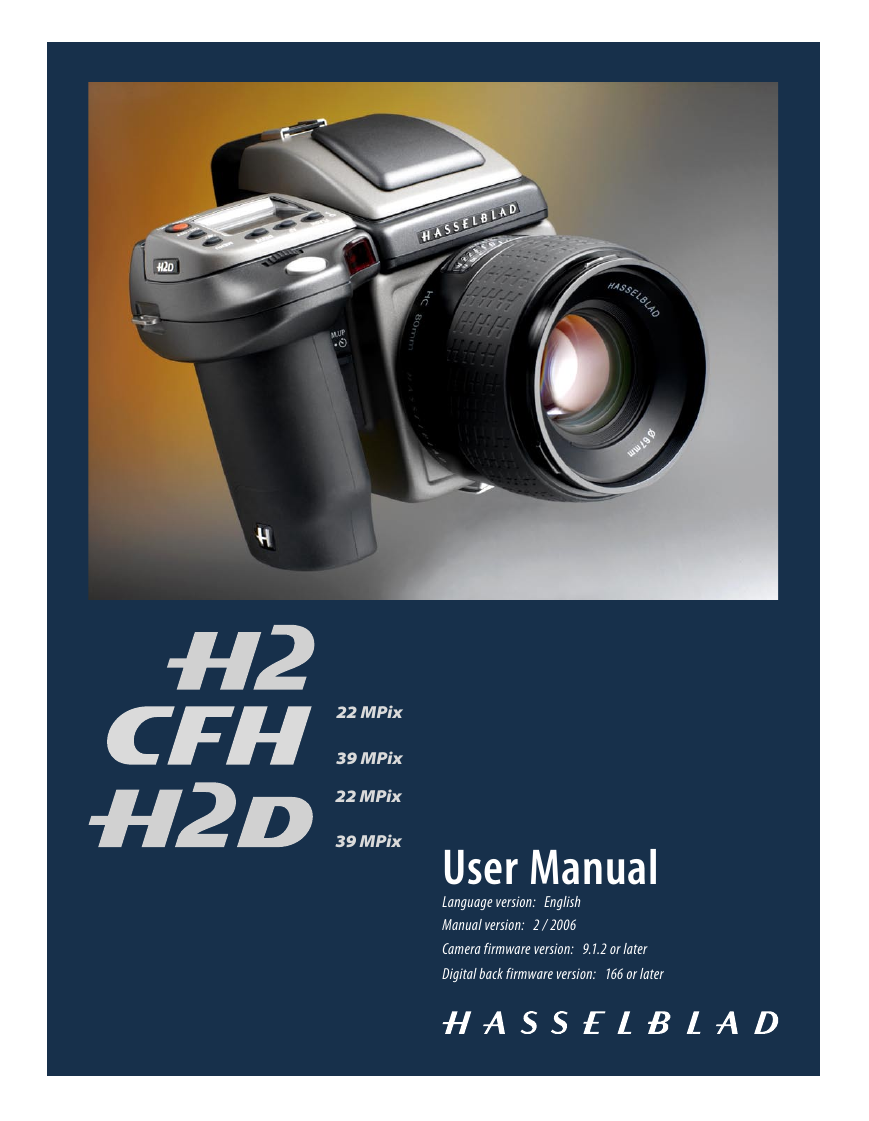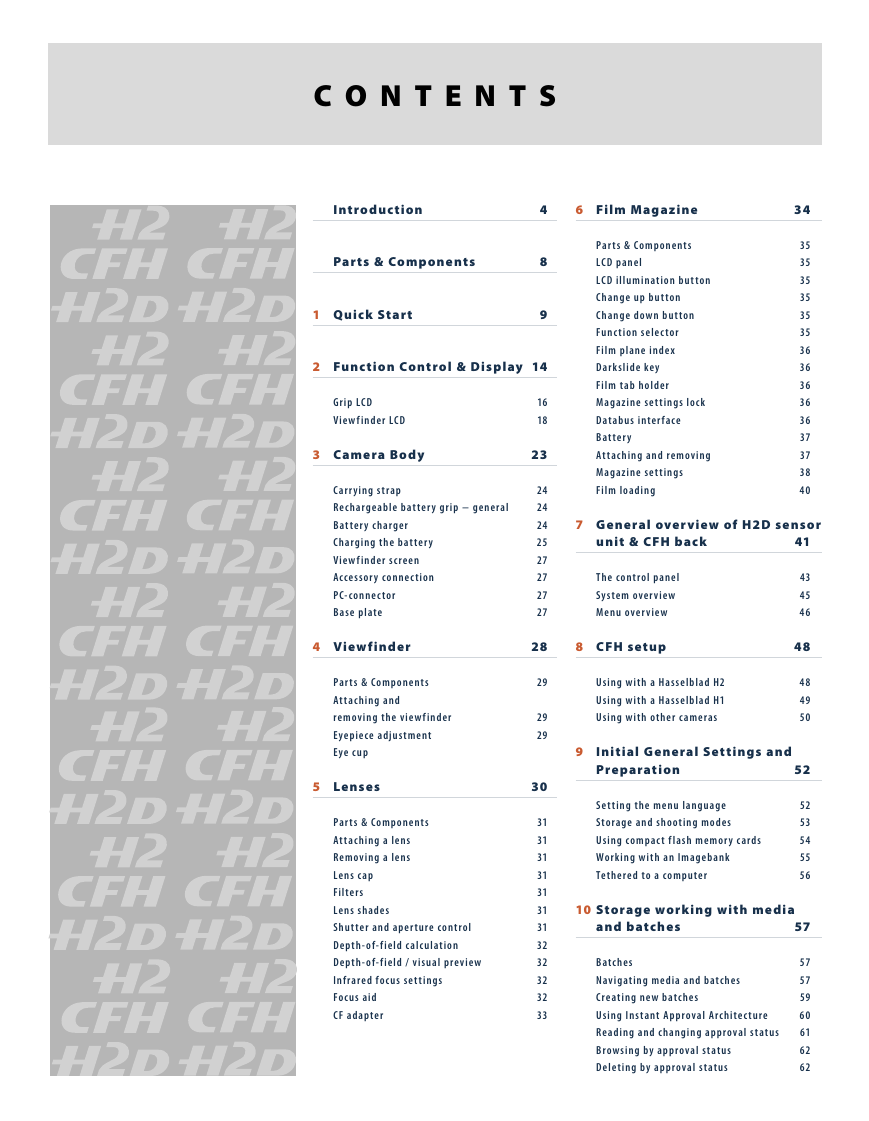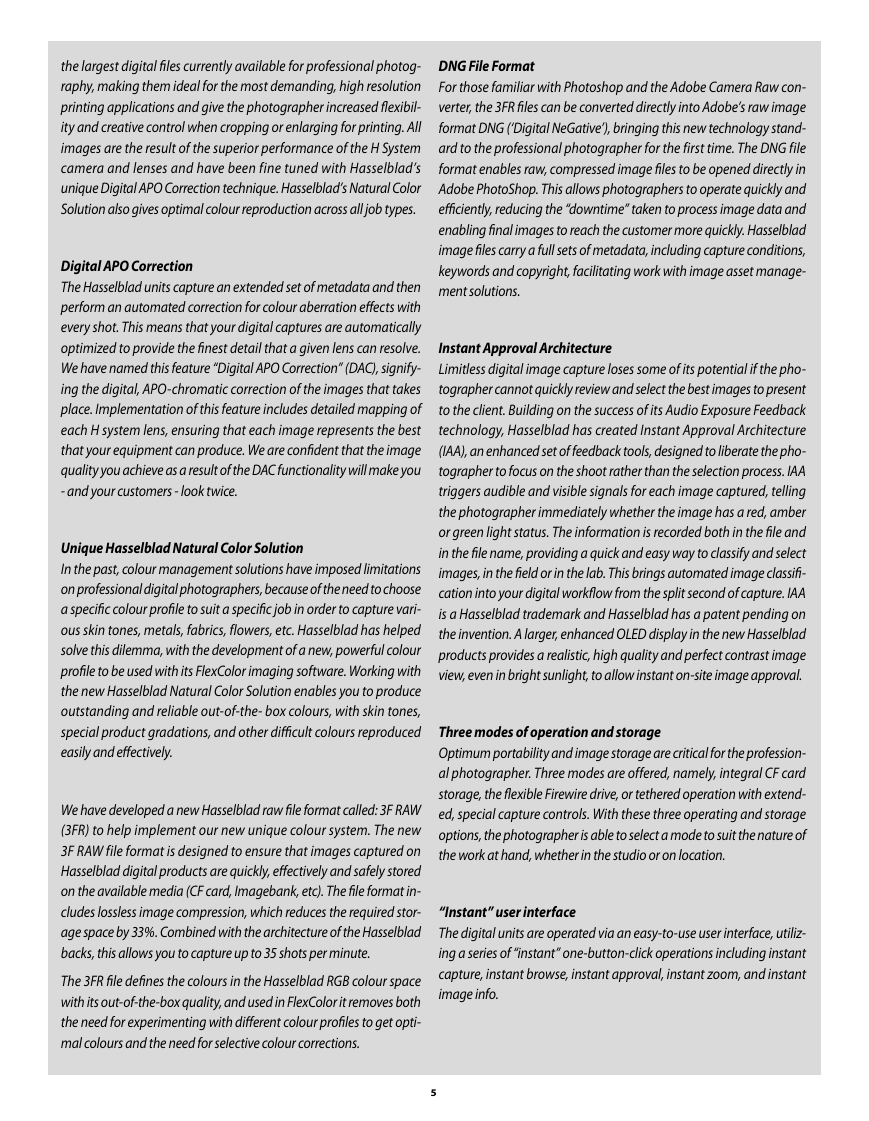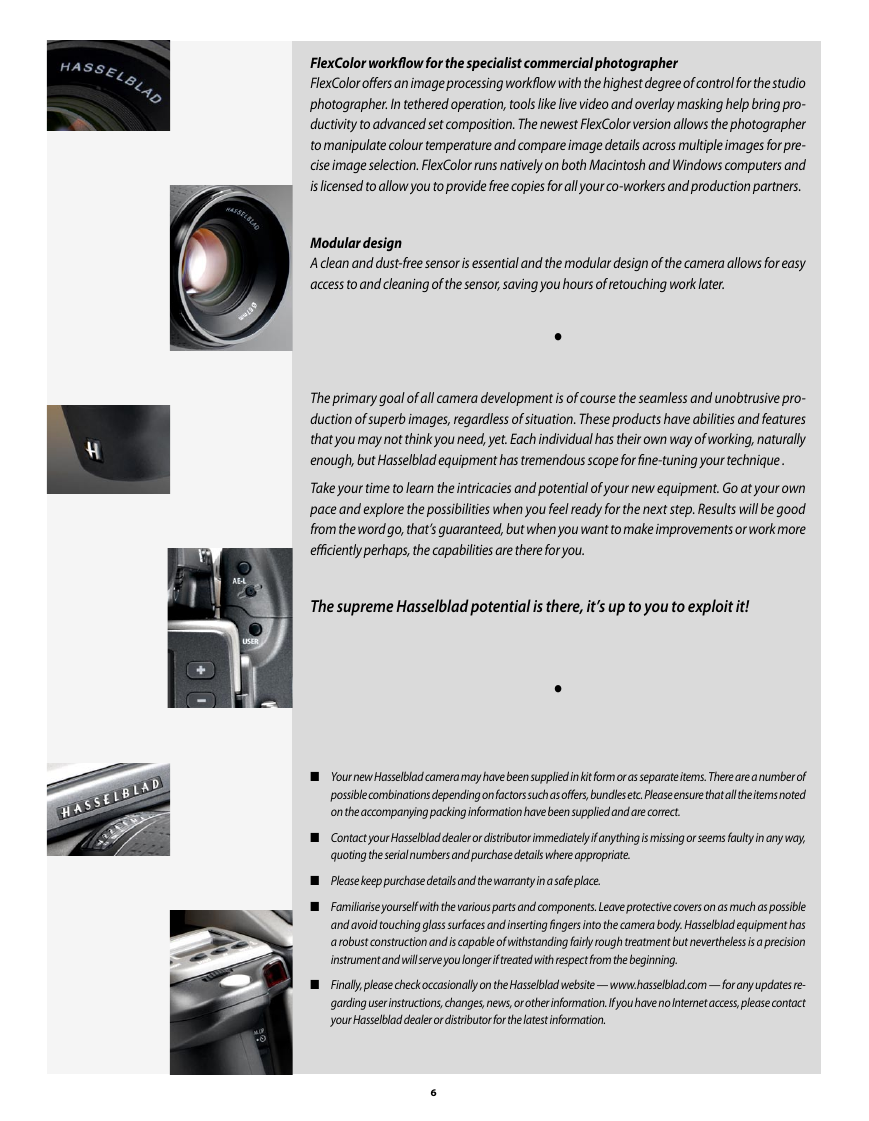22 MPix
39 MPix
22 MPix
39 MPix
User Manual
Language version: English
Manual version: 2 / 2006
Camera firmware version: 9.1.2 or later
Digital back firmware version: 166 or later
�
C O N T E N T S
Introduction
4
6 Film Magazine
34
4 Viewfinder
28
8 CFH setup
Parts & Components
1 Quick Start
8
9
2 Function Control & Display 14
Grip LCD
Viewfinder LCD
3 Camera Body
Carrying strap
Rechargeable battery grip − general
Battery charger
Charging the battery
Viewfinder screen
Accessory connection
PC-connector
Base plate
16
18
23
24
24
24
25
27
27
27
27
Parts & Components
Attaching and
removing the viewfinder
Eyepiece adjustment
Eye cup
5 Lenses
Parts & Components
Attaching a lens
Removing a lens
Lens cap
Filters
Lens shades
Shutter and aperture control
Depth-of-field calculation
Depth-of-field / visual preview
Infrared focus settings
Focus aid
CF adapter
29
29
29
30
31
31
31
31
31
31
31
32
32
32
32
33
Parts & Components
LCD panel
LCD illumination button
Change up button
Change down button
Function selector
Film plane index
Darkslide key
Film tab holder
Magazine settings lock
Databus inter face
Battery
Attaching and removing
Magazine settings
Film loading
35
35
35
35
35
35
36
36
36
36
36
37
37
38
40
7 General overview of H2D sensor
unit & CFH back
The control panel
System overview
Menu overview
Using with a Hasselblad H2
Using with a Hasselblad H1
Using with other cameras
41
43
45
46
48
48
49
50
9
Initial General Settings and
Preparation
52
Setting the menu language
Storage and shooting modes
Using compact flash memory cards
Working with an Imagebank
Tethered to a computer
52
53
54
55
56
10 Storage working with media
and batches
Batches
Navigating media and batches
Creating new batches
Using Instant Approval Architecture
Reading and changing approval status
Browsing by approval status
Deleting by approval status
57
57
57
59
60
61
62
62
�
11 Overview of viewing, deleting
63
and copying images
16 General Functions
99
Power−ON
Power−Standby
Power−OFF
Manual focus
Manual focus mode
Autofocus override in manual mode
Autofocus
Single Shot
Continuous
Autofocus mode
Drive
Single
Continuous
Profiles
Making a profile
Changing a profile name
100
100
100
100
101
101
101
101
102
102
103
103
103
104
104
105
17 Advanced Features
106
General overview of camera menu
Self Timer
Bracketing
Interval
Settings
Custom Options
Image Info
Text
Date & Time
System status
Customizable button function list
18 Flash
Flash measure
19 Optional Accessories
20 Appendix
107
108
110
112
113
113
117
118
120
121
122
123
126
127
129
Glossary
Technical specifications
Care, digital back /sensor unit
Equipment care, service and guarantee
130
134
137
139
Basic image browsing
Choosing the current batch
Browsing by approval status
Zooming in and out
Zooming in for more detail
Thumbnail views
Preview modes
Battery saver mode
Full-screen mode
Overexposure indicator
Deleting images
Transferring images
12 MENU—ISO, White balance,
Media, Browse
Menu overview
Navigating the menu system
Language
ISO
White balance
Media
Browse
13 MENU—Storage
Delete
Format
Copy
Batch
Default Approval Level
14 MENU—Settings
User Inter face
Camera
Miscellaneous
About
Default
63
63
63
64
64
64
65
67
67
67
68
68
69
69
69
71
71
72
72
73
74
75
79
80
81
82
83
84
85
90
91
92
15 Light Metering &
Exposure Control
Metering method
Exposure method
Manual exposure mode
Automatic exposure mode
AE-L button
Exposure compensation
93
94
95
95
96
97
98
�
Welcome to Hasselblad !
These three products represent the forefront of medium format photography
- both digital and analogue. Their unrivalled position is based on an accumula-
tion of experience spanning more than fifty years. By using Hasselblad equip-
ment you share the decision made by of some of the world’s best and most fa-
mous photographers. Congratulations on a wise choice!
The H system
The H system is the result of the most intensive technical development programme ever un-
dertaken by Hasselblad, the most prestigious medium-format camera manufacturer in the
world. It presents a list of features coloured by superlatives. What was once considered op-
tional is now integral, built around the three pillars of the Hasselblad reputation: Reliability,
Versatility and Interchangeability.
The list of features is long, varied and comprehensive. It includes: automatic focus with instant
manual override, dot-matrix LCDs, rapid button and control wheel user interface, integral
grip, integral fill-flash, multi-mode exposure metering, TTL flash control, extremely accurate
electronic leaf shutter, flash sync at all shutter speeds to 1/800s, eyeline viewfinder with 100%
view, dot matrix viewfinder LCD, lithium or rechargeable battery options, shutter speeds from
18 hours to 1/800s, user customization of functions, bracketing, interval timer, rapid access
user button, flash measure, integral diopter adjustment in viewfinder, zone system capability,
time-lapse photography, customized profiles and so on.
Film users can take advantage of automatic film speed setting with bar code, instant 120/220
interchangeability, integral dark slide, independent LCD illumination on magazines, auto-
matic film advance and film wind off, custom imprinting on frame edge including exposure
data, name, symbols, etc.,
CFH digital back / H2D sensor unit
These latest digital developments provide the photographer with the ability to exploit the
many possibilities available today to produce professional level files of unrivalled quality
while experiencing an efficient workflow.
Sensor
The sensor is more than twice the physical size of today’s 35mm sensors. This sensor holds
more and larger pixels, which guarantees superior image quality and provides moiré free col-
our rendering without gradation break-ups in even the finest lit surfaces. Images have unsur-
passed clarity and sharpness, thanks to the ultra-high pixel resolution. This sensor produces
4
�
the largest digital files currently available for professional photog-
raphy, making them ideal for the most demanding, high resolution
printing applications and give the photographer increased flexibil-
ity and creative control when cropping or enlarging for printing. All
images are the result of the superior performance of the H System
camera and lenses and have been fine tuned with Hasselblad’s
unique Digital APO Correction technique. Hasselblad’s Natural Color
Solution also gives optimal colour reproduction across all job types.
Digital APO Correction
The Hasselblad units capture an extended set of metadata and then
perform an automated correction for colour aberration effects with
every shot. This means that your digital captures are automatically
optimized to provide the finest detail that a given lens can resolve.
We have named this feature “Digital APO Correction” (DAC), signify-
ing the digital, APO-chromatic correction of the images that takes
place. Implementation of this feature includes detailed mapping of
each H system lens, ensuring that each image represents the best
that your equipment can produce. We are confident that the image
quality you achieve as a result of the DAC functionality will make you
- and your customers - look twice.
Unique Hasselblad Natural Color Solution
In the past, colour management solutions have imposed limitations
on professional digital photographers, because of the need to choose
a specific colour profile to suit a specific job in order to capture vari-
ous skin tones, metals, fabrics, flowers, etc. Hasselblad has helped
solve this dilemma, with the development of a new, powerful colour
profile to be used with its FlexColor imaging software. Working with
the new Hasselblad Natural Color Solution enables you to produce
outstanding and reliable out-of-the- box colours, with skin tones,
special product gradations, and other difficult colours reproduced
easily and effectively.
We have developed a new Hasselblad raw file format called: 3F RAW
(3FR) to help implement our new unique colour system. The new
3F RAW file format is designed to ensure that images captured on
Hasselblad digital products are quickly, effectively and safely stored
on the available media (CF card, Imagebank, etc). The file format in-
cludes lossless image compression, which reduces the required stor-
age space by 33%. Combined with the architecture of the Hasselblad
backs, this allows you to capture up to 35 shots per minute.
The 3FR file defines the colours in the Hasselblad RGB colour space
with its out-of-the-box quality, and used in FlexColor it removes both
the need for experimenting with different colour profiles to get opti-
mal colours and the need for selective colour corrections.
5
DNG File Format
For those familiar with Photoshop and the Adobe Camera Raw con-
verter, the 3FR files can be converted directly into Adobe’s raw image
format DNG (‘Digital NeGative’), bringing this new technology stand-
ard to the professional photographer for the first time. The DNG file
format enables raw, compressed image files to be opened directly in
Adobe PhotoShop. This allows photographers to operate quickly and
efficiently, reducing the “downtime” taken to process image data and
enabling final images to reach the customer more quickly. Hasselblad
image files carry a full sets of metadata, including capture conditions,
keywords and copyright, facilitating work with image asset manage-
ment solutions.
Instant Approval Architecture
Limitless digital image capture loses some of its potential if the pho-
tographer cannot quickly review and select the best images to present
to the client. Building on the success of its Audio Exposure Feedback
technology, Hasselblad has created Instant Approval Architecture
(IAA), an enhanced set of feedback tools, designed to liberate the pho-
tographer to focus on the shoot rather than the selection process. IAA
triggers audible and visible signals for each image captured, telling
the photographer immediately whether the image has a red, amber
or green light status. The information is recorded both in the file and
in the file name, providing a quick and easy way to classify and select
images, in the field or in the lab. This brings automated image classifi-
cation into your digital workflow from the split second of capture. IAA
is a Hasselblad trademark and Hasselblad has a patent pending on
the invention. A larger, enhanced OLED display in the new Hasselblad
products provides a realistic, high quality and perfect contrast image
view, even in bright sunlight, to allow instant on-site image approval.
Three modes of operation and storage
Optimum portability and image storage are critical for the profession-
al photographer. Three modes are offered, namely, integral CF card
storage, the flexible Firewire drive, or tethered operation with extend-
ed, special capture controls. With these three operating and storage
options, the photographer is able to select a mode to suit the nature of
the work at hand, whether in the studio or on location.
“Instant” user interface
The digital units are operated via an easy-to-use user interface, utiliz-
ing a series of “instant” one-button-click operations including instant
capture, instant browse, instant approval, instant zoom, and instant
image info.
�
FlexColor workflow for the specialist commercial photographer
FlexColor offers an image processing workflow with the highest degree of control for the studio
photographer. In tethered operation, tools like live video and overlay masking help bring pro-
ductivity to advanced set composition. The newest FlexColor version allows the photographer
to manipulate colour temperature and compare image details across multiple images for pre-
cise image selection. FlexColor runs natively on both Macintosh and Windows computers and
is licensed to allow you to provide free copies for all your co-workers and production partners.
Modular design
A clean and dust-free sensor is essential and the modular design of the camera allows for easy
access to and cleaning of the sensor, saving you hours of retouching work later.
•
The primary goal of all camera development is of course the seamless and unobtrusive pro-
duction of superb images, regardless of situation. These products have abilities and features
that you may not think you need, yet. Each individual has their own way of working, naturally
enough, but Hasselblad equipment has tremendous scope for fine-tuning your technique .
Take your time to learn the intricacies and potential of your new equipment. Go at your own
pace and explore the possibilities when you feel ready for the next step. Results will be good
from the word go, that’s guaranteed, but when you want to make improvements or work more
efficiently perhaps, the capabilities are there for you.
The supreme Hasselblad potential is there, it’s up to you to exploit it!
•
■ Your new Hasselblad camera may have been supplied in kit form or as separate items. There are a number of
possible combinations depending on factors such as offers, bundles etc. Please ensure that all the items noted
on the accompanying packing information have been supplied and are correct.
■ Contact your Hasselblad dealer or distributor immediately if anything is missing or seems faulty in any way,
quoting the serial numbers and purchase details where appropriate.
■ Please keep purchase details and the warranty in a safe place.
■ Familiarise yourself with the various parts and components. Leave protective covers on as much as possible
and avoid touching glass surfaces and inserting fingers into the camera body. Hasselblad equipment has
a robust construction and is capable of withstanding fairly rough treatment but nevertheless is a precision
instrument and will serve you longer if treated with respect from the beginning.
■ Finally, please check occasionally on the Hasselblad website — www.hasselblad.com — for any updates re-
garding user instructions, changes, news, or other information. If you have no Internet access, please contact
your Hasselblad dealer or distributor for the latest information.
6
�
Manual information
This manual covers most user aspects of the H2, H2D cameras and CFH digital backs.
The information is loosely divided between the products but quite naturally there is a
good deal of overlap. For example, the H2D sensor unit and the CFH digital back share
the identical menu structure and so that aspect appears under the same heading. The
logos on the first page of each chapter symbolize the content relevance in most cases.
Where appropriate in the text and for the the sake of simplicity, the H2 and H2D models
are collectively referred to as H2/D. In addition, the illustrations might show an H2 logo
instead of a H2D or a film magazine attached instead of a digital back. For the sake of
simplicity all possible variations and eventualities are therefore not illustrated.
Regarding the megapixel classification of your particular model; usage is the same. The
only noticeable difference will be logo appearance, file capture /storage speed, file size/
quality and last but not least picture quality of course!
Computer system requirements (H2D and CFH only)
Digital files naturally end up on a computer for processing. Image-storage and correction
requires a certain minimum standard regarding computer capabilities. Large images
will require a high-performance computer with plenty of memory, advanced graphics
capabilities and a recent operating system. In most cases, the computer should include
a FireWire 800/400 connector, which will enable you to load images directly from the
camera or Imagebank. To load images stored on the removable compact-flash card,
you could instead use a compact-flash card reader, but FireWire is recommended for
maximum flexibility.
Warnings and restrictions (H2D and CFH only)
•
•
•
•
Keep your H2D/CFH and all other computer equipment away from moisture wherever possible. If it
becomes wet, disconnect from power and allow it to dry before attempting to operate again.
Always take great care when you remove the sensor back for cleaning—the exposed filter that covers
the CCD sensor is vulnerable to damage.
Keep all cables connected to or from your camera and computer out of the way where they will not
be tripped over.
Never cover the ventilation openings on the digital back when it is active.
Please see later section on all general precautions and recommendations.
7
�
1. Flash unit hot-shoe
2. Rubber eyecup
3. Exposure mode and metering
method selector button
4. Exposure compensation button
5. Eyepiece adjustment dial
6. Magazine LCD
7. Magazine LCD illumination button
8. Magazine control buttons
9. Magazine settings lock
10. AE-L button
11. Film wind-off button
12. User button
13. Rear control wheel
14. Grip LCD
15. Support strap lug
16. Camera control buttons
17. Magazine databus
18. Front control wheel
19. Shutter release button
20. Battery holder button
21. Release cord socket
22. Stop down button
23. Battery holder retaining lever
24. Mirror up button
25. Battery holder
26. Flash unit
27. Viewfinder screen
28. Focus assist light
29. Mirror
30. Distance and depth-of-field scales
31. Focusing ring
32. Lens shade bayonet
33. Filter screw thread
34. Databus connection
35. Viewfinder release button
36. Flash unit catch
37. Viewfinder attachment hook
38. Viewfinder databus connection
39. Magazine release button
40. Flash PC socket
41. Camera strap lug
42. Lens release button
43. Magazine support
44. Databus connection
45. Quick coupling tripod plate
46. Film tab holder
47. Magazine darkslide key
48. Film holder key
49. Magazine support groove
50. Databus connection
Parts & Components
(H2 with film magazine)
1.
2.
3.
4.
5.
6.
7.
8.
9.
10.
11.
12.
13.
14.
15.
16.
17.
18.
19.
20.
21.
22.
23.
24.
25.
35.
36.
37.
38.
39.
40.
41.
42.
43.
44.
45.
8
26.
27.
28.
29.
30.
31.
32.
33.
34.
46.
47.
48.
49.
50.
�
















 2023年江西萍乡中考道德与法治真题及答案.doc
2023年江西萍乡中考道德与法治真题及答案.doc 2012年重庆南川中考生物真题及答案.doc
2012年重庆南川中考生物真题及答案.doc 2013年江西师范大学地理学综合及文艺理论基础考研真题.doc
2013年江西师范大学地理学综合及文艺理论基础考研真题.doc 2020年四川甘孜小升初语文真题及答案I卷.doc
2020年四川甘孜小升初语文真题及答案I卷.doc 2020年注册岩土工程师专业基础考试真题及答案.doc
2020年注册岩土工程师专业基础考试真题及答案.doc 2023-2024学年福建省厦门市九年级上学期数学月考试题及答案.doc
2023-2024学年福建省厦门市九年级上学期数学月考试题及答案.doc 2021-2022学年辽宁省沈阳市大东区九年级上学期语文期末试题及答案.doc
2021-2022学年辽宁省沈阳市大东区九年级上学期语文期末试题及答案.doc 2022-2023学年北京东城区初三第一学期物理期末试卷及答案.doc
2022-2023学年北京东城区初三第一学期物理期末试卷及答案.doc 2018上半年江西教师资格初中地理学科知识与教学能力真题及答案.doc
2018上半年江西教师资格初中地理学科知识与教学能力真题及答案.doc 2012年河北国家公务员申论考试真题及答案-省级.doc
2012年河北国家公务员申论考试真题及答案-省级.doc 2020-2021学年江苏省扬州市江都区邵樊片九年级上学期数学第一次质量检测试题及答案.doc
2020-2021学年江苏省扬州市江都区邵樊片九年级上学期数学第一次质量检测试题及答案.doc 2022下半年黑龙江教师资格证中学综合素质真题及答案.doc
2022下半年黑龙江教师资格证中学综合素质真题及答案.doc